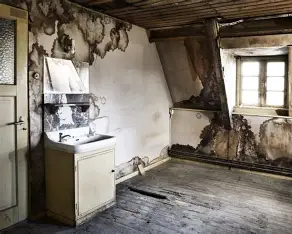When most people dream of life in France, they imagine cozy stone houses, exposed wooden beams, and lush gardens. What they don’t imagine is a fungus silently devouring the very foundation of that dream.
Welcome to the little-known — and shockingly common — threat of Merula, a destructive wood-decaying fungus that thrives in homes across France.
🧫 What is Merula?
Merula lacrymans, often referred to as dry rot, is a type of fungus that attacks damp or poorly ventilated timber. Despite the nickname “dry” rot, it requires some moisture to start growing. Once established, Merula spreads rapidly through wooden structures, feeding on cellulose and leaving the wood brittle, dry, and crumbling.
This fungal invader is particularly dangerous because it often starts growing in hidden, enclosed spaces like under floors, behind walls, or in poorly insulated attics — meaning you may not notice it until significant damage has already been done.

🔍 How to Recognize the Signs
Early detection is crucial. Watch out for these warning signs in your French home:
⚠️ 1. Warping or Cracking Wood
Affected timber may appear shrunken, cracked, or warped. You might notice uneven floors or spongy stair treads.
⚠️ 2. White or Grey Cotton-Like Growth
This is the fungus itself spreading — it can look like thick cobwebs or cotton wool in corners, joists, or crawl spaces.
⚠️ 3. A Musty, Mushroom-Like Odor
One of the most consistent clues is an earthy, fungal smell, especially in cellars, basements, or behind walls.
⚠️ 4. Rust-Colored Spores
In advanced cases, Merula produces reddish-brown spore dust that can settle on nearby surfaces — a major red flag.

🏚️ What’s at Risk?
If not caught early, Merula can affect:
- Roof beams
- Floorboards and subfloors
- Staircases
- Wooden doors and window frames
- Even adjacent brickwork or plaster, as it can carry moisture through masonry
Severe infestations may require major reconstruction, costing thousands of euros.
🛠️ How to Protect Your Home in France
Preventing a Merula infestation requires vigilance, especially in older properties or those in damp regions.
✅ 1. Control Humidity
Ensure proper ventilation in attics, basements, and crawlspaces. Consider installing dehumidifiers if necessary.
✅ 2. Fix Leaks Promptly
Water from leaking pipes, roofs, or faulty gutters creates the perfect environment for fungal growth.
✅ 3. Use Treated Wood
Where possible, use pre-treated or pressure-treated timber during repairs or renovations.
✅ 4. Inspect Hidden Areas
If you live in or buy a character property, have a building professional conduct regular checks of concealed woodwork.
✅ 5. Act Fast if You Suspect a Problem
Call in a certified pest or structural specialist. DIY solutions aren’t enough once Merula has taken hold.
📚 Want to Be a Smarter Homeowner in France?
Learn more about Merula and other surprising home hazards in our comprehensive guide:
Bonjour to France: Your French Home – part of the Bonjour to France book series.
You’ll discover:
- How to navigate French property laws
- Common maintenance traps
- Regional risks (from mushrooms to termites!)
- Insider tips from expats living in historic homes
📦 Get your copy here:
🇫🇷 Amazon France
🇬🇧 Amazon UK
🇺🇸 Amazon USA
🏡 Protect your dream. Don’t let Merula turn it into a nightmare.
#BonjourToFrance #FrenchHome #LivingInFrance #HomeProtection #DryRot #PropertyCare #MovingToFrance #ExpatsInFrance





